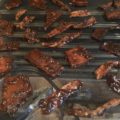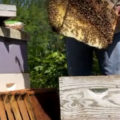As a second-year beekeeper, I wanted to share a little information about what I’ll be doing with my bees as spring approaches. I installed two packages of bees in the spring of 2010 and, despite a rocky start (bees attempting to abscond,) I consider my first year a huge success. Finding the local bee club and being able to bounce questions off my club friends any time I needed help was invaluable. I have not found a lot of information on the net specifically about the new beekeeper coming into his/her second year of beekeeping, so I thought I’d put together my intentions based on what I’ve learned thus far. Please keep in mind, this is an account of what I will be doing and by no means is this the definitive guide.

First, I obviously need to be sure my bees made it through the winter. I put a candy board on my hives in the fall and I feel it was a good thing to do. I’ve checked my bees recently and they are still alive. Assuming my bees make it through the winter, the next thing I’ll be thinking about is building up a maximum number of foragers by early spring. I’ve chosen May 1 as the day I want the maximum number of worker bees of foraging age getting the best Spring has to offer. So, I’ll work backwards to understand what I need to do and when I need to do it.
If worker bees take roughly 21 days to emerge from their cell and then another 21 days until their first foraging flight, I will want the queen laying at her maximum 40-42 days before May 1. That puts me around late March to get her started. I’ve already encased pollen patties in the sugar near the top of my candy board in the fall, but of course I’ll be checking it as spring approaches to see if the bees are in to it. If they aren’t, that’s the first manipulation I’ll do. We need to stimulate the queen about a week to 10 days earlier than our 42 days of brood-rearing so that she is closer to laying at her maximum for this brood-rearing period. So, roughly March 15th is when I will ensure the hive has pollen and sugar-water to ensure we have the most formidable foraging population by May 1. Between March 1st and Mother’s Day, the weather in Indiana always has to be played by ear. We are challenged with variable temperature fluctuations that can make or break a hive.
By having a strong population of foragers to gather water, nectar and pollen, we help promote a healthy colony, naturally. Bolstering the bees general health starts by acknowledging the basics. I was pleased to see my bees out on Feb. 12 and 13 doing cleansing flights.
So, having pollen patties and a 1:1 sugar water feeding regimen going by March 15th is my goal. Cindy’s advice below describes another component to our goal–that is, finding the right time to get the syrup in place of the candy. It shouldn’t happen too early, but if we want our max foraging force, it’s essential that we stimulate hive productivity by a simulated nectar flow.
“The advantage of a syrup feeding w/ thin syrup is that it simulates a honey-flow and encourages both brood and wax production. Again, not something you want to do too early. As long as there are moisture/temperature concerns, you will want to keep the candy on, as I really think that sugar does a lot to help absorb the excess moisture.”
I plan to keep my candy boards on through March and into April… removing them when the threat of moisture (and cold snaps) ease. I envision first placing bags of sugar water (with pin holes poked on top) in the sugar board where the bees have eaten a void in the candy (I’m certain one hive will have such void). When temperatures begin to warm up above 65 degrees F, I will lift out brood frames and inspect for eggs and sealed brood. As long as we see some temperatures that permit taking a look, I’ll watch for swarm cells and confirm the rate of production is going the way that is intended. I hope to find a decent brood pattern and frames of capped and uncapped brood.

It’s important that we do not rotate the hive bodies too early. During the winter the cluster of bees gradually move up towards the top hive eating stored honey (and also into my candy board that I put on top) So, by the time Spring hits, the cluster is found in the upper hive body, leaving the bottom body empty of bees and honey. The colony will naturally expand in the upper hive bodies and begin to use up the space. The congestion could stimulate the colony to swarm at the next opportunity. So, I will reverse the hive bodies at at to-be-determined time to position the nesting area on the bottom, giving the colony room to expand upwards again. I will take Jim’s advice as to when and how I’ll rotate hive bodies.
“We usually wait until it is warm enough to move each frame. Brood goes to the bottom middle, honey on the sides, empty comb over the brood. We also clean the bottom boards while we are doing this. If you bring an empty box and a clean bottom board with you, this will go pretty quick.”
It would be great to get a nice day in February to take a peek inside to see if we can find eggs and check the general health of the queen (by finding some good frames of brood and noting the pattern.) However, we will not want to be lifting frames out of the hive until we have a day with temperatures at or above 65 degrees F.

In early March, I’ll begin the syrup-feeding regimen mentioned above as long as temperatures allow. Ensuring the hive has a good supply of sugar-water and pollen is essential. They will need the pollen at the right time to begin the brood-rearing cycle we are planning between March and May 1.
Of course, nothing goes like the text books say… so I’ll update with notes and changes if I have any over the next couple of months. Here’s to a successful 2011 season with your bees.





Leave a Reply